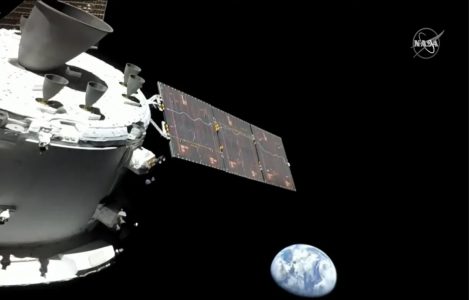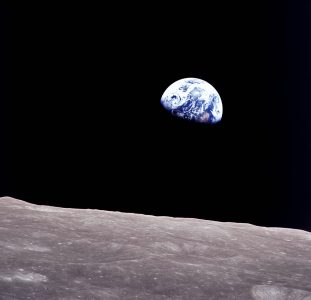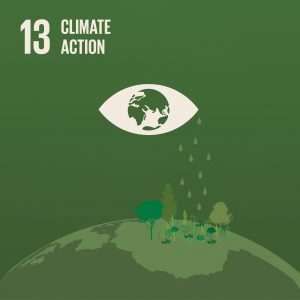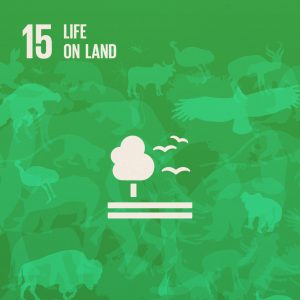The Gift of Perspective Created on December 24, 1968
“To see the Earth as it truly is, small and blue and beautiful in that eternal silence where it floats is to see ourselves as riders on the Earth together, brothers on that bright loveliness in the eternal cold.” Archibald MacLeish, 1968
On November 16 this year, NASA launched an uncrewed Orion spacecraft to our moon, the first phase of a new lunar landing program that in the near future will return humans to the moon for the first time since December 1972, fifty years ago.
This image was taken nine hours into Orion’s flight.

Photo credit: NASA
It reminded me of the stunning first images taken of Earth from the moon on December 24, 1968, by Apollo 8 astronaut Bill Anders.
The significance of one of those first images, the photograph known as Earthrise, cannot be overestimated. I think it is the single most important photograph ever taken, a gift to humanity of sobering and inspiring perspective.

Photo credit: Astronaut Bill Anders, Apollo 8. NASA
In the intervening years, similar images have become common to the point where we have become blasé about seeing our home from this vantage point. Perhaps these images elicit, at best, a “cool” or a “wow” before thought drifts on to something else.
But the power and meaning of these photographs, their sobering and inspiring lessons, remain to be absorbed if we stop to reflect on them. Given our planetary predicaments, it would be most wise for us to do so.
The story of how Earthrise was captured is fascinating. The event was recreated on video with stunning precision by NASA and offered to the public on the photo’s 45th anniversary.
The Apollo 8 crew of Frank Borman, Jim Lovell, and Bill Anders were busy photographing and mapping the moon’s surface. All three were highly trained, disciplined engineers. Two were test pilots and one a fighter pilot, all laser-focused on the mission. Yet all that was momentarily forgotten when Anders, the first to see it, blurted out, “Oh, my God look at that picture over there!”
The view was life changing. The impact on them individually is described in Rocket Men, by Robert Kurson, a marvelous account of the Apollo 8 mission.
Earthrise was the most beautiful sight Borman had ever seen, the only color visible in all the cosmos. The planet just hung there, a jewel on black velvet, and it struck him that everything he loved…was on that tiny sphere, a brilliant blue and white interruption in a never-ending darkness, the only place he or anyone else had to call home.
Lovell was overwhelmed by the smallness of Earth, home to three and a half billion people (54 years later, 8 billion – ed.) who, from this vantage point, all wanted the same things – a family to love, food to eat, a roof over their heads, children to kiss. From this distance he could scarcely comprehend the fragility of Earth’s atmosphere, a layer no thicker than the skin of an apple, the only thing that protected those lives and life itself.
To Anders, Earth appeared as a Christmas tree ornament, hung radiant blue and swirling white in an endless black night. From here, it was no longer possible to pick out countries or even continents…. You saw how small the planet is, how close all of us are to one another, how the only thing any of us really has … is each other. As Apollo 8 came around the limb of the moon… it seemed to Anders, so strange – the astronauts had come all this way to discover the moon, and yet here they had discovered the Earth.
The gift of that view is multifaceted. It’s a gift of beauty, of awe, of inspiration. No one had any idea Earth was this beautiful. It is also a sobering view. No one had realized how small, fragile, and finite Earth is.
Whenever I contemplate Earthrise, I feel all those things. Sometimes I sit in a dark room and imagine myself as one of the 24 human beings who, sitting in a tiny craft in groups of three between 1968 and 1972, had the privilege of seeing our home from a quarter of a million miles away. I get a small sense of the visceral, life-changing impact of that experience.
I think if each of us really reflected on and absorbed the lessons of Earthrise, we would treat each other and our planet very differently. The sad truth is that 54 years later, humanity has yet to appreciate and heed the lessons this photograph teaches.
If we really understood our precarious, lonely, desperately fortunate place in the universe and our utter interdependence with each other and all life on Earth, would we risk our very existence by conducting wars over religion, land, resources, and political power? Would we spend trillions on weapons, accept zero-sum mindsets with everyone out for themselves, tolerate injustice, inequality, and prejudice? Would we continue shredding the ecological life support systems of the planet for short-term, narrowly distributed economic gain? Would we accept the vast and growing gap between those with superabundance and those with essentially nothing, and conflate consumerism and economic “growth” with the achievement of human wellbeing?
We can’t keep behaving like this. It is true that many decent individuals and organizations are working to change things on behalf of individual and collective wellbeing and the common good, but on balance, we are blowing it.
At the end of each calendar year, near the solstice, cultures and religions around the world reflect on the meaning of life and the universally shared human values of kindness, compassion, and generosity. What if this year we act in alignment with our values, taking them to heart individually and collectively? What if we hold each other and our leaders accountable for life-affirming behaviors?
What if, fifty years later, we fully embrace the just renewed lessons of Earthrise? A few moments in quiet contemplation, reading about the experiences of travelers to our moon and living vicariously as an Apollo astronaut, imagining ourselves observing Earth in wonder and humility as it comes into view, is enough to move us deeply.
As a species, we are capable of extraordinary things. Forget the technological accomplishment of traveling to the moon; I’m thinking about the human characteristics of courage, self-sacrifice, dedication, and commitment to a worthy effort shared by groups of people working together and what we can accomplish. I’m thinking about countless unseen acts of common humanity that happen every day all over the planet among families, friends, and strangers. I’m thinking about our unlimited capacity for such acts, our talent for artistic brilliance and creativity, our sensitivity to the beauty of nature, and our ability to experience joy, wonder, and love.
We have within us, as individuals and as a species, all we need to cultivate a world worth living in, a world nurtured into being by the best within us, a world like that described by Senator Gaylord Nelson, founder of Earth Day: “The objective is an environment of decency, quality, and mutual respect for all other human beings and all other living creatures.”
Perhaps as this year ends, each of us will take an extended moment to reflect, to absorb more deeply the gift of Earthrise and realize as did Apollo 14 astronaut Alan Shepard when he took a long, hard look at the Earth from the moon’s surface, “it is, in fact, very finite, very fragile…so incredibly fragile.”
Nothing less than our survival depends on it.
Learn about the SDGs & AU and our contributions related to this post.






